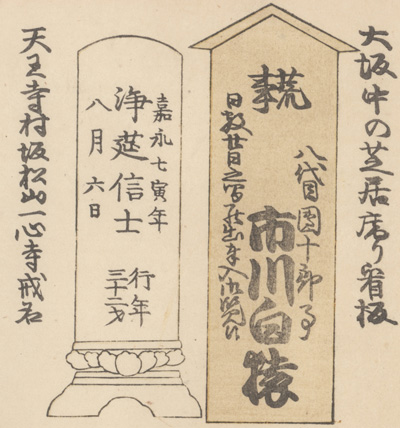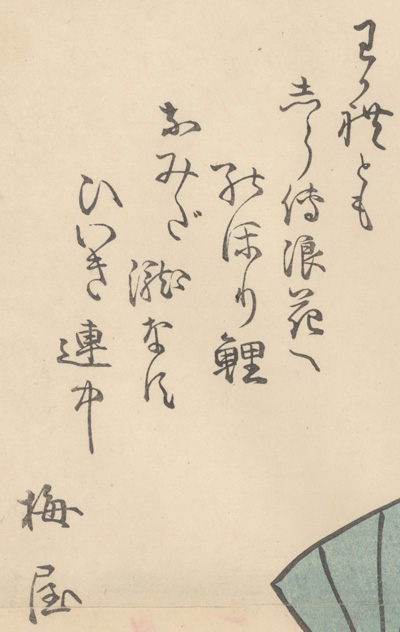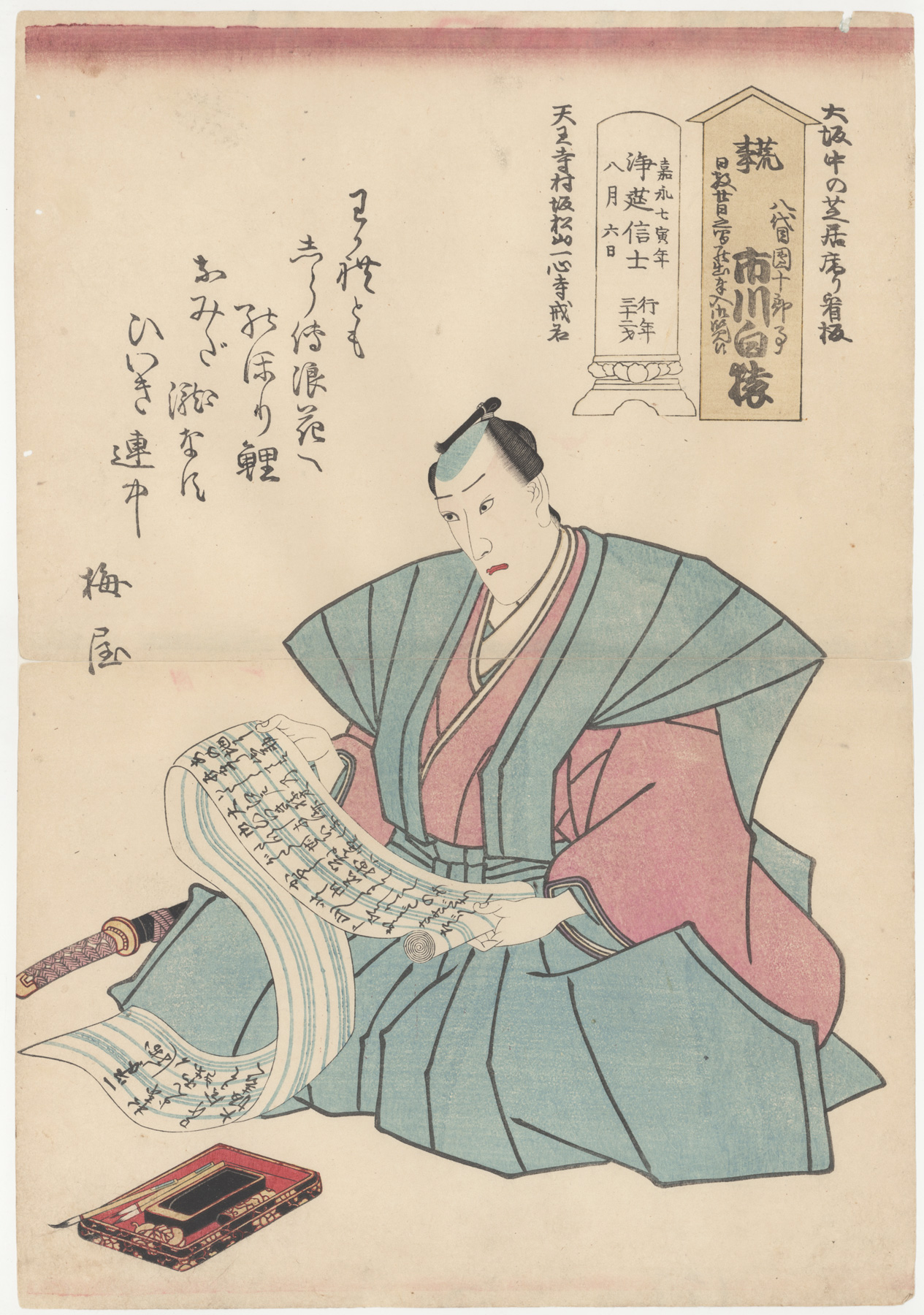About This Print
This memorial print (shini-e) issued upon the death of the actor Ichikawa Danjūrō VIII on August 8, 1854 shows the actor in a death robe (kamishimo) holding a scroll on which he has, perhaps, written his death poem. A lacquer box with pen and ink stone lie before him. The bold script in the center column of theater signboard in the upper right of the print (detail shown below), shows us the name 市川白猿 (Ichikawa Hakuen) another stage name for Ichikawa Danjūrō VIII.1 As with many shini-e neither the artist's signature or seal or the publisher's mark are present. In addition, government censor seals were not required on memorial prints.Transcription
Sources: The Tsubouchi Memorial Theatre Museum, Waseda University website (accessed 10/14/2008) and Tokyo Metropolitan Library website http://archive.library.metro.tokyo.jp/da/detail?tilcod=0000000003-00011389 (accessed 10/14/2018)
 | 大坂中の芝居庵り看板 Osaka theater signboard 荒事 八代目市川団十郎事市川白猿 日数廾日之間罷出奉入御覧候 aragoto Ichikawa Danjūrō VIII... Ichikawa Hakuen [III]... 嘉永七寅年八月六日 浄莚信士 行年三十二才 Kaei 7 [1854] Year of the tiger August 8, 32 years old at age of death 天王寺村坂松山一心寺戒名 |
 | わかれともしらて浪花へのほり鯉なみだ滝なすひいき連中 梅屋 A memorial poem signed by Umeya 梅屋. [Umeya Kakuju 梅屋鶴寿 (1801-1864/1865); real name Murota Matabei; a kyōka poet who operated a machiai, assignation teahouse, named Umenoya in Nagayagawa-chō. His name appears on many actor memorial poems on shini-e during his active period.] |
The Death of Ichikawa Danjūrō VIII
Source: website of Scholten Japanese Art http://www.scholten-japanese-art.com/printsV.php?printID=1874
"The death of actor Ichikawa Danjuro VIII (1823-1854) was a devastating event in mid-19th century popular culture. The beloved Danjuro VIII, belonging to the prestigious Danjuro line of actors for whom many of the most prominent kabuki roles were reserved, committed suicide at a way-side inn while en route to Osaka to perform with his father, Ichikawa Danjuro VII (Ichikawa Ebizo V, 1791-1859). The 30 year old was perhaps kabuki's most-promising rising star. So obsessive were his fans that the barrel of water in which he would briefly hide while in the classic role of the misunderstood ne'er-do-well Sukeroku was later sold at auction for a huge sum. And pastry shops would likewise capitalize on Danjuro VIII's popularity by offering cracked bean paste buns that would replicate the grotesque burns of Danjuro VIII's 'scar-faced' Yosaburo character."
About Shini-e
Source: "Shini-e or 'Memorial Portraits", by F. K. Lotgering appearing in Andon (Bulletin of the Society for Japanese Arts and Crafts), No. 4, 1981 and the website of the National Museum of Japanese History, Bimonthly Magazine “REKIHAKU” No.151 A Witness to History https://www.rekihaku.ac.jp/english/outline/publication/rekihaku/151/witness.html (accessed 10/14/2018)Shini-e or Memorial Portraits are generally somber colored standardized depictions of a recently deceased kabuki actor, although a few shini-e were issued for non-actors associated with artistic circles. They were largely a 19th century phenomenon that disappeared after the deaths of the stars Ichikawa Danjūrō IX and Onoe Kikugorō V (see the print The actor Onoe Kikugorō V, Memorial Print) in 1903 and Ichikawa Sadanji in 1904. Most shini-e are single sheet prints, although diptychs and triptychs do exist.
A complete text for a typical shini-e contains the professional stage name of the deceased; his posthumous name (already selected during his life-time), date of and age at death, burial place and a death poem (jisei) by the deceased or memorial poem written by fan, friend or family member.
The deceased actor is generally shown in a death robe (kamishimo), in either a seated or full-length standing posture. Prayer beads, an incense burner, a spring of Japanese anise or a scroll containing a sutra are often present, along with other symbols relating to death and the afterlife.
Publishers rushed to release these prints as soon as a death was either announced or rumored, as there was an eager audience of fans, family and friends awaiting them. For extremely popular artists such as Ichikawa Danjūrō VIII, over 100 memorial prints have been identified.
市川 団十郎 (5 October 1823 ~ 8 August 1854)
Source: Kabuki 21 website http://www.kabuki21.com/danjuro8.php
Stage names: Ichikawa Danjūrō VIII, Ichikawa Ebizō VI, Ichikawa Shinnosuke II
Other name: Ichikawa Hakuen (III)
Connection: Great-great-great-great-grandfather: Ichikawa Danjūrō I, Great-great-great-grandfather: Ichikawa Ebizô II (Danjūrō II), Great-great-grandfather: Ichikawa Ebizō III (Danjūrō IV), Great-Grandfather: Ichikawa Hakuen I (Danjūrō V)
Father: Ichikawa Danjūrō VII
Brothers: Ichikawa Danjūrō IX, Ichikawa Ebizō VII, Ichikawa Ebizō VIII, Ichikawa Komazō VI, Ichikawa Enzō I, Ichikawa Kūzō
"Like his father, Ichikawa Danjūrō VIII excelled in the aragoto ('rough-stuff') roles for which the Ichikawa lineage was famous. But as well as audacious young heroes, he was also extremely successful in the various roles of young lover (nimaime). Together with his good looks, this made him especially popular with female fans. When he played Sukeroku, in which he had to immerse himself in a barrel of water, the water was subsequently sold at exorbitant cost to avid admirers. Even when he had to appear as Yosaburō with a scarred face, pastry shops sold beanpaste buns with cracked outer skins called 'Yosaburō buns, which were devoured by the actor's fans. Despite his success, or even because of it, he was plagued by personal problems, perhaps exacerbated by his early achievements and the jealousy this caused among older actors. In 1854 [August 8], during a tour of performances in Osaka with his father, he was found in his inn with his wrists slashed. He was suffering from massive debts, caused by his lifestyle, which emulated the excesses of his father." (from the The Fitzwilliam Museum Website).
Source: Kabuki 21 website http://www.kabuki21.com/danjuro8.php
Stage names: Ichikawa Danjūrō VIII, Ichikawa Ebizō VI, Ichikawa Shinnosuke II
Other name: Ichikawa Hakuen (III)
Connection: Great-great-great-great-grandfather: Ichikawa Danjūrō I, Great-great-great-grandfather: Ichikawa Ebizô II (Danjūrō II), Great-great-grandfather: Ichikawa Ebizō III (Danjūrō IV), Great-Grandfather: Ichikawa Hakuen I (Danjūrō V)
Father: Ichikawa Danjūrō VII
Brothers: Ichikawa Danjūrō IX, Ichikawa Ebizō VII, Ichikawa Ebizō VIII, Ichikawa Komazō VI, Ichikawa Enzō I, Ichikawa Kūzō
"Like his father, Ichikawa Danjūrō VIII excelled in the aragoto ('rough-stuff') roles for which the Ichikawa lineage was famous. But as well as audacious young heroes, he was also extremely successful in the various roles of young lover (nimaime). Together with his good looks, this made him especially popular with female fans. When he played Sukeroku, in which he had to immerse himself in a barrel of water, the water was subsequently sold at exorbitant cost to avid admirers. Even when he had to appear as Yosaburō with a scarred face, pastry shops sold beanpaste buns with cracked outer skins called 'Yosaburō buns, which were devoured by the actor's fans. Despite his success, or even because of it, he was plagued by personal problems, perhaps exacerbated by his early achievements and the jealousy this caused among older actors. In 1854 [August 8], during a tour of performances in Osaka with his father, he was found in his inn with his wrists slashed. He was suffering from massive debts, caused by his lifestyle, which emulated the excesses of his father." (from the The Fitzwilliam Museum Website).
1 according to the Kabuki21 website while Ichikawa Danjūrō VIII never held the name of Ichikawa Hakuen III he was considered as the third holder of the name.
Print Details
| IHL Catalog | #1836 |
| Title or Description | The Actor Ichikawa Danjūrō VIII, memorial print |
| Artist | Anonymous Artists |
| Signature | not signed |
| Seal | not sealed |
| Publication Date | August 1854 |
| Publisher | unknown - no publisher seals or marks |
| Carver | |
| Printer | |
| Impression | excellent |
| Colors | good |
| Condition | fair - print was cut in half horizontally across the center and repaired with a strip of paper tape; light soiling overall, small insect damage upper right margin |
| Genre | ukiyo-e; shini-e |
| Miscellaneous | |
| Format | vertical oban |
| H x W Paper | 14 3/8 x 9 7/8 in. (36.5 x 25.1 cm) |
| H x W Image | |
| Literature | |
| Collections This Print | Tokyo Metropolitan Library 5721-c45; Edo-Tokyo Museum 92200404; Witherspoon Art Museum 1992.4358.75; National Diet Library Call Number 本別9-28; The Tsubouchi Memorial Theatre Museum, Waseda University 014-0218, 014-0243, 114-0108 |
last revision:
10/15/2018


